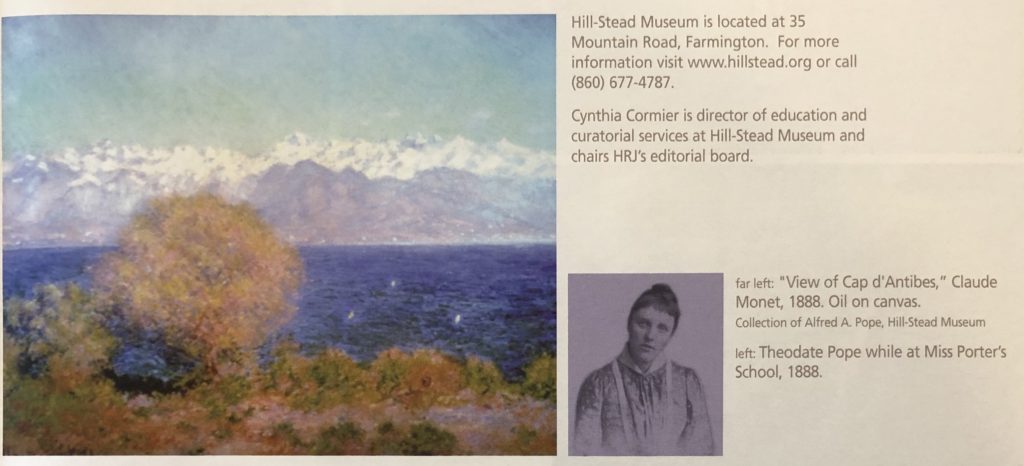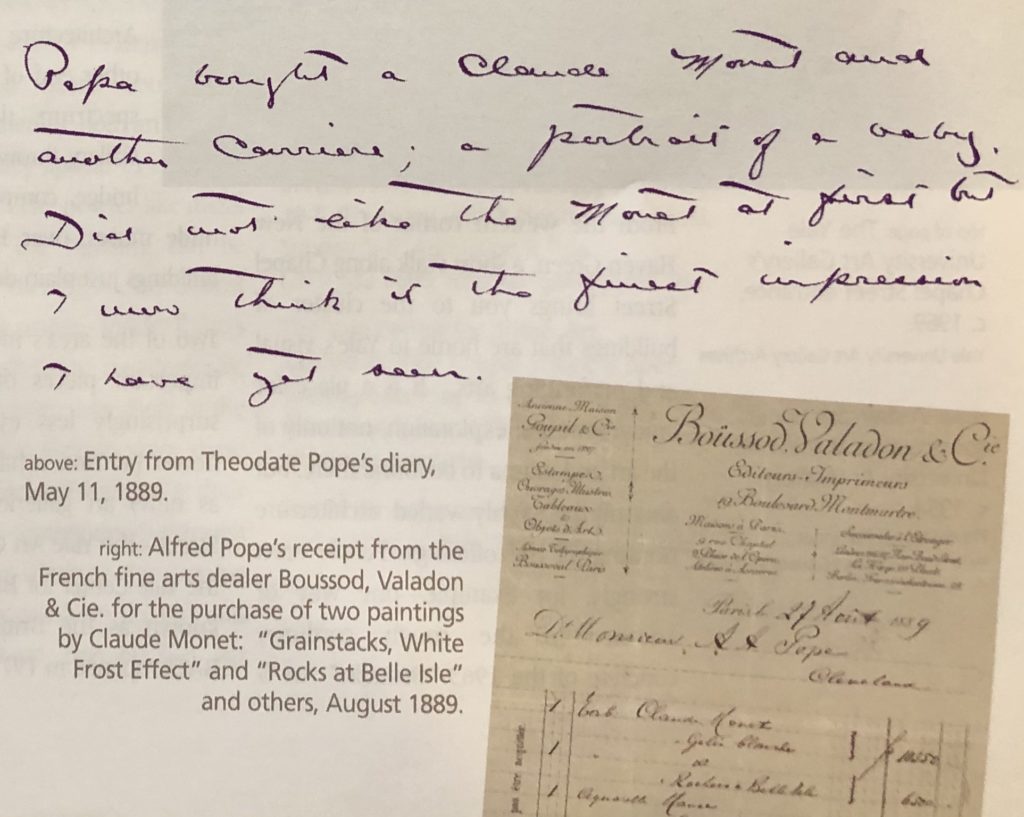By Cynthia Cormier
(c) Connecticut Explored Inc. WINTER 2006/07
Subscribe/Buy the Issue!
How is it that several of the finest examples of French Impressionist painting have come to reside in the grand country estate known as Hill-Stead in Farmington—the house and collection American novelist Henry James described in 1907 as “apparently conceived—and with great felicity—on the lines of a magnified Mount Vernon, and in which [may be found]an array of modern ‘impressionist’ pictures, mainly French”? The diary of the house’s architect—and daughter of its owner—reveals the answer.
The story begins in 1888 when Ohio-born Theodate Pope (1867-1946) came east to finish her education at Miss Porter’s School for Girls in Farmington, where Theodate thrived intellectually and personally, becoming part of a largely academic and socially aware community of progressive women. There she decided to become an architect and preservationist. Ultimately, she settled in Farmington, but not before taking a 10-month grand tour of Europe with her parents, traveling to all the major capitals of Europe, visiting museums and galleries, and gathering treasures to bring back to the United States.
Alfred Pope, Theodate by his side, visited the now famed dealers who represented the French Impressionist artists: Durand-Ruel, Goupils and Boussod, Valadon. After months of looking and learning they returned to the U.S. with three new paintings by Claude Monet (“View of Cap d’Antibes,” 1888, “Grainstacks, White Frost Effect,” 1889, and “Rocks at Belle Isle,” 1889; the first two are still on view at Hill-Stead). Receipts for much of their art collection remain in the archives at Hill-Stead Museum, as do Theodate’s grand tour diaries.
It is through her diary entries that we get a glimpse of what it was like for American collectors as they first discovered the Impressionists. Shortly after arriving in Paris they went to visit the private home of art dealer Durand-Ruel. Of this early experience of seeing Impressionist art Theodate writes on November 9, 1888,
This morning we all … went to Mr. Durand-Ruel’s house to see his collection of pictures made by impressionists. One or two seemed good, the others seemed to me, who can not appreciate them, just stuff. I think perhaps the men of that school began with a good idea and their pictures are certainly fresh in style, but when they offer us a canvas that we cannot tell if the painting on it is meant to represent water or a field I think to say the least they are off. I wonder if some men do not depend on this coming craze to make inexcusable pictures and sell them to the uninstructed (or fools) as samples of this new school?
Six months later, on May 9, 1889, Theodate writes from Paris:
…Today we spent all the time from half past ten until five in the afternoon at the exposition. It is in very rough state as yet but we managed to see the French and English pictures very well. The pictures were arranged well, as often as possible those by the same artist were hung near one another so that at a glance you could see the characteristic points of any certain painter…. Now the impressionists are interesting, but I doubt if any of the work they are now doing will last. It has its place in history because they came in just the right time. They are showing us that nature should be studied out of doors & that no landscape ought to be painted in the studio. They are bringing us a freshness that Corot, Rousseau, Daubigny, and other artists of that school never dreamed of. Never the less they are going too far in the opposite direction but still it takes some men to go beyond the line in order to bring others to it or as Papa says the impressionists are shouting in order to be heard.
Two days later she wrote:
…Went to Goupils and met Uncle Ned [Mrs. Pope’s brother, who was an art student in Paris] and Mama. …Papa bought a Claude Monet and another Carrière (French artist Eugene Carrière, 1849-1906); portrait of a baby. Did not like Monet at first but now I think it is the finest impression I have yet seen. We could not have appreciated it had we not been in the Midi….
The painting Theodate refers to is “View of Cap d’Antibes.” Like Monet, the Popes had traveled to Antibe, a small town in the south of France on the Mediterranean Sea, and Theodate recognized the blue waters of the Mediterranean and the snow-capped mountains of the Maritime Alps that mark the border between France and Italy.

left: Claude Monet, “View of Cap d’Antibes,” 1888. right: Theodate Pope while at Miss Porter’s School, 1888. Hill-Stead Museum
By the end of their extended grand tour, Theodate had gained solid appreciation for the work of the Impressionists. By August 19, 1889 she writes: “Am very anxious to have father buy a picture of Monet’s that is at Goupils now. It is the best picture by that artist I have ever seen, but father does not fancy it particularly. Too bad, he’ll regret not getting it some day.” This painting entitled “Gelee blanche” (“Grainstacks, White Frost Effect”), may be the very same one her father buys on August 29, 1889 from Boussod, Valadon.
Alfred A. Pope continued to collect fine and decorative art in the 1890s and 1900s. Upon his and his wife’s deaths, their collection was bequeathed to Theodate. Theodate appreciated the broader value of this “array of modern ‘impressionist’ pictures” and left her family home, Hill-Stead, and its entire contents to the public as a museum. The collections, the house, and the surrounding 150-acre estate remain as they were when Theodate and her family lived there. Hill-Stead’s archive, including Theodate’s many diaries, is an important resource for researchers studying the history of collecting and for those interested in the experience of Americans traveling abroad in the late 19th century.
Cynthia Cormier was director of education and curatorial services at Hill-Stead Museum and is a member of CT Explored‘s editorial team.
Explore!
Read more stories about Hill-Stead and Connecticut’s Art History on our TOPICS page.
Hill-Stead Museum
35 Mountain Road, Farmington.
For more information on Hill-Stead visit www.hillstead.org or call (860) 677-4787.

